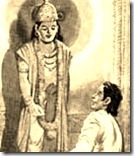 “The Lord heard the story of Sakshi-gopala with great pleasure because He wanted to impress upon the atheists that the worshipable Deities in the temples approved by the great acharyas are not idols, as alleged by men with a poor fund of knowledge.” (Shrila Prabhupada
“The Lord heard the story of Sakshi-gopala with great pleasure because He wanted to impress upon the atheists that the worshipable Deities in the temples approved by the great acharyas are not idols, as alleged by men with a poor fund of knowledge.” (Shrila Prabhupada
Shri Krishna Chaitanya, the Supreme Personality of Godhead Himself in the form of a preacher, a kind-hearted saint who did not discriminate when disseminating the universal peace formula that is bhakti-yoga, is extremely pleased to hear stories relating to Lord Krishna
 The accounts of historical incidents found in Vedic literature seem too good to be true, so there may be a tendency to think that the information was mentally concocted, stories that are meant to have a symbolic importance, provide moral lessons more than anything else. From Lord Chaitanya’s personal example, however, we learn that both the wonderful historical incidents documented in the Vedas and the divine nature of the deity representation of the Supreme Lord are real. Every person has their own interpretations and viewpoints based on their personal understanding, but this doesn’t mean that authority should never be accepted. If the skeptical attitude were applied universally, there would be no such thing as crime. The cells in the prison houses would have to be opened, for if every person were an authority figure, then even the thief could claim to be pious. “You say that I am a criminal, but that is your interpretation. My opinion is that I am innocent. I had a right to take another person’s property. Since we are both entitled to our opinions, how can any person say who is right and who is wrong?”
The accounts of historical incidents found in Vedic literature seem too good to be true, so there may be a tendency to think that the information was mentally concocted, stories that are meant to have a symbolic importance, provide moral lessons more than anything else. From Lord Chaitanya’s personal example, however, we learn that both the wonderful historical incidents documented in the Vedas and the divine nature of the deity representation of the Supreme Lord are real. Every person has their own interpretations and viewpoints based on their personal understanding, but this doesn’t mean that authority should never be accepted. If the skeptical attitude were applied universally, there would be no such thing as crime. The cells in the prison houses would have to be opened, for if every person were an authority figure, then even the thief could claim to be pious. “You say that I am a criminal, but that is your interpretation. My opinion is that I am innocent. I had a right to take another person’s property. Since we are both entitled to our opinions, how can any person say who is right and who is wrong?”
When the thief applies this logic, the practice is laughed at, made fun of, and not taken seriously in the least bit. Yet these same arguments are put forth about spirituality and Vedic concepts by those with a poor fund of knowledge, and somehow they are taken seriously. The truth is that even skepticism represents an assertion. In the skeptical attitude, the person putting forth their opinions wants others to accept them. Yet in order to accept something as factual, even an opinion like skepticism, there must be some authority established. Without authority, why would anyone believe anything that anyone else says?
The Vedas are the ancient scriptures of India, and one of their most concise works is the Bhagavad-gita, which was sung on the battlefield of Kurukshetra some five thousand years ago by Lord Krishna, the Supreme Lord, the fountainhead of Vedanta philosophy. Veda means “knowledge” and anta means “end”, so Vedanta represents the summit of knowledge, the last word on information that really matters. Though the Gita delves into a variety of topics, the final conclusion is that Krishna is God and that the soul’s occupational duty is to willingly surrender unto Him through a mood of pure love. With this devotion comes happiness for every party involved. Krishna is God, but this doesn’t mean that the Lord takes only one form. There are many non-different expansions of Krishna, allowing for people to worship the Supreme in their mood of choice.
 Only the personal expansions of Krishna are equal to the original. The list of the notable personal expansions is given in the sacred texts like the Shrimad Bhagavatam. Therefore those who worship Vishnu, Rama, Narasimha
Only the personal expansions of Krishna are equal to the original. The list of the notable personal expansions is given in the sacred texts like the Shrimad Bhagavatam. Therefore those who worship Vishnu, Rama, Narasimha
In a similar manner, the part and parcel expansions of Godhead have roles to play, but they are not the same as God. The guru is considered the empowered incarnation delivering the message of Godhead. The guru is treated the same as God, but nowhere is it said that he is equal to Krishna. Nevertheless, many mental speculators have commented on the Bhagavad-gita by saying that in His conclusion Krishna doesn’t really mean that one should surrender unto Him. Rather, one has to surrender to the “Krishna” residing within them. Since the guru is self-realized, he is the same Krishna.
Obviously, such theories are completely bogus and not based on authority. Yet when these conclusions are challenged by those who actually follow the Vedic teachings espoused by Shri Krishna Himself, the pretenders can only counter with skepticism. “Well, that’s your interpretation. How can you say that I am wrong?” To settle any doubts, to expose the pretenders and cheaters for who they are, the Supreme Lord personally descends to earth from time to time. Lord Chaitanya’s advent marked one such occasion. As Krishna in the guise of a devotee, Lord Chaitanya never insisted that others worship Him. He was Krishna, as is revealed in the end of the Shrimad Bhagavatam
 Have the pretender gods ever lifted a gigantic hill and held it up over their heads for seven consecutive days without a problem? Have they displayed the universal form which is so awe-inspiring that the eyes can’t even look at it for too long because of the fear it instills? Have they saved a child in the womb from the attack of a deadly atomic weapon? Have they created this and many other universes through a simple exhalation? Have they provided pleasure to millions of devotees by playing their flute?
Have the pretender gods ever lifted a gigantic hill and held it up over their heads for seven consecutive days without a problem? Have they displayed the universal form which is so awe-inspiring that the eyes can’t even look at it for too long because of the fear it instills? Have they saved a child in the womb from the attack of a deadly atomic weapon? Have they created this and many other universes through a simple exhalation? Have they provided pleasure to millions of devotees by playing their flute?
Lord Krishna is the reservoir of pleasure, for God is eternally situated in bliss. Knowledge acquisition, exhibitions of yogic siddhis, and possession of material opulence are but partial representations of the Supreme Lord’s glories, almost insignificant abilities that can only attract the attention of those not yet given towards bhakti-yoga, or devotional service
A long time back two brahmanas, members of the priestly class, were travelling around India visiting pilgrimage sites. One brahmana was older and from a higher class while the other was younger and not very esteemed socially. The younger brahmana offered such nice service during this trip that the elder one became immensely pleased. He promised to give away his daughter’s hand in marriage to the younger brahmana. The younger brahmana was a little surprised, for he knew that the man’s family would not agree to the proposal. Therefore he made the elder man promise in front of the deity of Sakshi-gopala that was in the temple they were visiting. Swearing before a deity was a big deal. It was sort of like swearing to tell the truth before giving testimony in court, except that the oath was taken much more seriously.
When the elder brahmana returned home, he told his family what had happened. Not surprisingly, they objected to his idea. The brahmana knew that he had promised before the deity and that this would raise an issue. The man’s son suggested that his father simply say that he forgot what he said that day. This is the standard line used by lawyers and those trying to cheat. By saying you can’t remember, you technically aren’t lying, for you haven’t made an outright confirmation or denial.
 When the younger brahmana visited his friend later on and asked what was going on with the marriage arrangements, he was surprised to learn that the deal was now off. Not only was he rejected, but the elder brahmana’s son started accusing him of poisoning his father and making him act in crazy ways. Reminding the older man of the promise he made in front of the deity, the younger brahmana hoped to save his friend from the sinful reaction of lying before Krishna. The elder brahmana said that if the same deity could be brought in their presence to testify to the oath, then he would give away his daughter. Obviously the thought was that the deity was simply stone and thus incapable of doing anything.
When the younger brahmana visited his friend later on and asked what was going on with the marriage arrangements, he was surprised to learn that the deal was now off. Not only was he rejected, but the elder brahmana’s son started accusing him of poisoning his father and making him act in crazy ways. Reminding the older man of the promise he made in front of the deity, the younger brahmana hoped to save his friend from the sinful reaction of lying before Krishna. The elder brahmana said that if the same deity could be brought in their presence to testify to the oath, then he would give away his daughter. Obviously the thought was that the deity was simply stone and thus incapable of doing anything.
It’s interesting to note that for the elder brahmana the deity was important enough to make the oath in front of, but when it came time to back up his words, when things really mattered, the same deity was taken to be just material elements. Matter does not have Krishna’s personal presence, but when it is used in an authorized way to construct the worshipable figure, the archa-vigraha, it becomes spiritualized. How this is possible cannot be understood through mental exercise. The reality of the change must initially be accepted as fact based on the authority of the acharyas, those who lead by example.
The younger brahmana went back to the temple and asked the deity to help him out. Krishna always hears the pleas of His devotees, so He spoke to the brahmana through His deity form. He told the brahmana to proceed to his friend’s home, while He, as the deity, would follow from behind. The brahmana was not to look back to see if the deity was following. He was to know that Krishna was behind him by the sound of the Lord’s ankle bells. The brahmana would daily offer rice to the deity to keep the Lord satisfied.
Sure enough, the deity of Sakshi-gopala made the journey to the elder brahmana’s home. Astonished to see the witness standing before him, the elder brahmana was left with no choice but to agree to the original arrangement, which he had promised before the deity. Lord Chaitanya loved this story because it showed how the deity is not just a collection of material elements aimed at furthering realization of Brahman, or the impersonal light of Truth. Krishna’s deities are fully empowered because they are non-different from Him. They are worshipable, which means that they accept the obeisances made to them in full devotion and faith.
“If one offers Me with love and devotion a leaf, a flower, fruit, or water, I will accept it.” (Lord Krishna, Bhagavad-gita, 9.26)
 In the Bhagavad-gita, Lord Krishna states that anyone who offers Him a leaf, flower, fruit, or some water with devotion will have their offering accepted and enjoyed by the Lord. Why would we want to offer anything to God? The question should really be why would we not? We offer so much to other people already, so why not take a little time to give attention to the source of every benediction in life? Even if we can’t sacrifice food or make an opulent offering to the deity, we can give some time to the hearing process.
In the Bhagavad-gita, Lord Krishna states that anyone who offers Him a leaf, flower, fruit, or some water with devotion will have their offering accepted and enjoyed by the Lord. Why would we want to offer anything to God? The question should really be why would we not? We offer so much to other people already, so why not take a little time to give attention to the source of every benediction in life? Even if we can’t sacrifice food or make an opulent offering to the deity, we can give some time to the hearing process.
Just sitting back and hearing about Krishna eventually reveals the knowledge necessary for enlightenment and gaining reinstatement into the eternal occupation that is devotional service. Just as Lord Chaitanya was delighted by hearing the story of Sakshi-gopala during His travels in India, we are warmed to the heart by hearing about Shri Gaurahari’s delight. He delivers the fallen souls of the Kali Yuga by distributing Krishna-prema freely, to anyone who wants it. In this marketplace, there is no scarcity, as the Supreme Lord has an endless supply of love to give to those who wish to cherish it and welcome it into their hearts. As Sakshi-gopala, Krishna vouched for the poor brahmana a long time ago, and as Shri Chaitanya Mahaprabhu, He confirms the Lord’s promise in the Bhagavad-gita to deliver the surrendered souls.
In Closing:
Around India did Mahaprabhu travel,
At one story in particular did He marvel.
To the vow of the brahmana whose logic went amiss.
Did Sakshi-gopala testify, the deity as witness.
A long time ago, two brahmanas there were,
To a marriage arrangement did they both concur.
“To you my young friend will I give the hand of my daughter,
You have treated me well, as if I were your father.”
Since he was very poor, the younger was hesitant to accept,
“In stature you are superior to me, surely your family will object.”
The younger then made the elder swear before the deity,
Sakshi-gopala, Shri Krishna Himself, the reservoir of beauty.
But when he returned home, the elder’s family did not agree,
“What kind of deal have you made, this is crazy don’t you see?”
When the younger visited the elder to see if the marriage was set,
The elder replied, “There is no deal. What I said before I do forget.”
The younger then asked Sakshi-gopala for help, to the deity did he talk.
“I will testify to the truth. Do you go to his home, behind you I will walk.”
Thus on the road the young brahmana did Sakshi-gopala, the deity, follow,
After hearing the truth from Shri Krishna, his humble pie did the elder swallow.
By the mercy of the Lord did the elder finally give up his objection,
The deity is Shri Krishna Himself, so to the devoted it gives all protection.
In hearing this story did Shri Krishna Chaitanya always delight,
Reciting it now, we pray that He may shine His mercy upon us so bright.